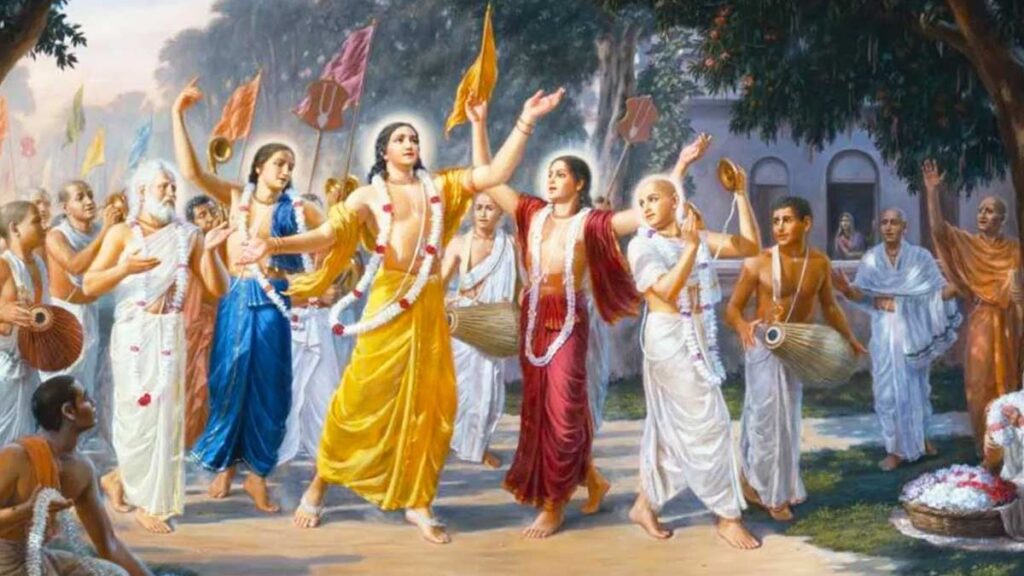Bhakti Yoga, often referred to as the “path of devotion,” is one of the four main paths of yoga in Hinduism, emphasizing love and devotion to a personal deity. Rooted in the Sanskrit word “Bhakti,” which means “devotion” or “love,” this yoga is about developing an intimate connection with the divine. Unlike other forms of yoga that focus on physical postures or intellectual understanding, Bhakti Yoga centers on cultivating a loving, devoted relationship with God as the means to attain spiritual enlightenment. This journey offers practitioners a profound experience of inner peace, unity, and transcendence.
In this blog post, we’ll explore the essence of Bhakti Yoga, its principles, practices, and the spiritual benefits it brings.

Understanding Bhakti Yoga
Bhakti Yoga is rooted in ancient Indian philosophy, primarily derived from the teachings of the Bhagavad GitaHow Bhagavad Gita Enlightens Your Life, a revered Hindu scripture where Lord Krishna explains the path of devotion to Arjuna. Unlike other yoga paths, such as Jnana Yoga (the path of knowledge) and Karma Yoga (the path of action), Bhakti Yoga emphasizes emotional surrender to the divine, allowing the heart to guide the practitioner. It is through love, compassion, and a deep sense of surrender that individuals can transcend the ego and feel connected to something greater than themselves.
The ultimate goal of Bhakti Yoga is to experience divine love and union with the supreme. This path does not require sophisticated rituals or complex practices; rather, it encourages simplicity, sincerity, and faith. Through prayer, chanting, and acts of service, the devotee’s mind and heart become absorbed in God, and this devotion leads them closer to enlightenment.
Key Principles of Bhakti Yoga
Bhakti Yoga’s core principles are centered around love, devotion, and surrender. These principles guide practitioners in deepening their connection with the divine:
- Love and Compassion: Bhakti Yoga teaches unconditional love and compassion towards all beings. By seeing God in every living creature, practitioners cultivate empathy and kindness, realizing that every soul is an expression of the divine.
- Surrender and Faith: True devotion requires surrendering the ego and trusting in the divine’s wisdom. This surrender allows individuals to let go of material attachments and anxieties, embracing a life filled with grace and purpose.
- Detachment from Material Desires: Bhakti Yoga encourages detachment from material possessions and desires, emphasizing that spiritual fulfillment cannot be found through worldly pursuits. The more one is detached from material cravings, the closer they come to experiencing divine love.
- Selflessness: Bhakti Yoga promotes a selfless attitude, inspiring practitioners to serve others without expecting anything in return. Selfless service (seva) is an integral part of Bhakti, symbolizing love and humility.
Forms of Bhakti Yoga
There are several forms and stages of Bhakti, each reflecting a different intensity and nature of devotion:
- Sakamya Bhakti (Conditional Devotion): This is the initial stage where devotion is often motivated by personal desires or material gains. Practitioners pray and perform rituals seeking God’s blessings for personal welfare.
- Nishkamya Bhakti (Unconditional Devotion): At this stage, devotion becomes unconditional, with no expectation of reward. The devotee surrenders completely to God, with pure love and dedication.
- Apara Bhakti (Lower Form of Devotion): In Apara Bhakti, devotees worship God with rituals and ceremonies. This form serves as a stepping stone for deepening devotion.
- Para Bhakti (Higher Form of Devotion): This is the ultimate stage, where the devotee experiences oneness with the divine. In Para Bhakti, the ego dissolves, and the heart and soul merge with God’s love.

Practices of Bhakti Yoga
Practicing Bhakti Yoga can take many forms, all of which center around acts of devotion that deepen the connection with the divine. Here are some common practices:
- Kirtan (Devotional Singing): Kirtan, or the singing of hymns and mantras, is a powerful form of Bhakti. By repeating sacred names and praises of God, practitioners cultivate love and peace in their hearts.
- Japa (Repetition of Mantras): Japa involves chanting a specific mantra, often using a mala (prayer beads). This repetitive chanting quiets the mind, allowing for a deep connection with the divine.
- Puja (Worship and Offerings): Puja involves making offerings, such as flowers, incense, or food, as an expression of love and respect. By treating God as an honored guest, practitioners reinforce their devotion.
- Satsang (Spiritual Gatherings): Satsang involves gathering with like-minded individuals for spiritual discourse or prayer. It fosters a community of shared devotion and provides support on the spiritual path.
- Seva (Selfless Service): Service to others is an important aspect of Bhakti Yoga. Serving others with love and humility is seen as serving God, as it reflects the oneness of all beings.
- Meditation on the Divine: Bhakti Yoga includes meditative practices focused on visualizing or contemplating the divine. This meditation enhances one’s sense of presence and unity with God.
Benefits of Practicing Bhakti Yoga
Bhakti Yoga offers numerous physical, mental, and spiritual benefits, helping practitioners transform themselves and reach higher levels of consciousness:
- Emotional Healing: Bhakti Yoga encourages self-acceptance, compassion, and forgiveness. By cultivating love for the divine, practitioners often experience emotional healing, letting go of past pain and trauma.
- Inner Peace and Joy: Devotion fills the heart with joy and peace, as it helps individuals transcend the ordinary concerns of daily life. The practice of Bhakti Yoga allows for an enduring sense of contentment and inner calm.
- Improved Relationships: Bhakti Yoga teaches love, kindness, and patience, fostering healthier and more harmonious relationships. When one practices unconditional love, it naturally extends to everyone in their life.
- Connection to Divine: The ultimate goal of Bhakti Yoga is to realize the divine within oneself. This deep spiritual connection brings profound insights, a sense of purpose, and freedom from worldly suffering.
- Reduction of Stress and Anxiety: Bhakti Yoga’s practices, such as chanting and meditation, have been shown to reduce stress and anxiety, promoting relaxation and mental clarity.
- Self-Realization: Through devotion and surrender, practitioners move beyond ego-based thinking, coming closer to the true essence of their soul and the interconnectedness of all life.
The Role of Bhakti Yoga in Modern Life
In a fast-paced, materialistic world, Bhakti Yoga offers a refreshing approach to finding inner peace and spiritual fulfillment. Unlike other paths that require intense discipline or intellectual rigor, Bhakti Yoga is accessible to everyone, regardless of age, background, or level of spiritual knowledge. It provides a way to slow down, reconnect with the heart, and find solace amid life’s challenges.
For those struggling with stress, isolation, or a sense of purposelessness, Bhakti Yoga provides a pathway to reconnect with their spiritual essence and build a sense of community. By fostering a deep relationship with the divine, individuals can transcend the emptiness that often accompanies modern life and find meaning through devotion.

Famous Bhakti Yoga Practitioners
Throughout history, many saints and sages have embraced Bhakti Yoga, spreading its teachings and inspiring countless others. Some of the most well-known Bhakti practitioners include:
- Saint Mirabai: A 16th-century poet-saint, Mirabai’s devotion to Lord Krishna is legendary. Her songs and poems express the intense love and longing for God, inspiring generations of Bhakti practitioners.
- Ramanuja: An 11th-century philosopher and theologian, Ramanuja championed Bhakti as a path to salvation. His teachings emphasized the importance of love and surrender to God.
- Chaitanya Mahaprabhu: Known for his ecstatic devotion to Krishna, Chaitanya Mahaprabhu spread the practice of kirtan, making it one of the most popular forms of Bhakti.
- Tulsidas: A renowned poet-saint, Tulsidas composed the Ramcharitmanas, an epic dedicated to Lord Rama. His devotion to Rama has inspired countless devotees across generations.
Conclusion
Bhakti Yoga offers a path to enlightenment that is rooted in love, compassion, and devotion. In practicing Bhakti, individuals are not just connecting with a higher power; they are transforming their inner world, developing virtues like kindness, selflessness, and forgiveness. Bhakti Yoga teaches that true enlightenment is not found in intellect or knowledge alone but through surrender and divine love.
Whether through song, prayer, or acts of service, Bhakti Yoga provides a way to experience the divine in every aspect of life. In embracing the path of Bhakti, one not only finds inner peace and joy but also realizes a profound oneness with all beings, illuminating the path to spiritual enlightenment.


